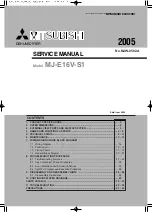
26
The tower pressure gauge of the on-line tower should
read line pressure. Air should not be leaking from the
purge-repressurization valve of the on-line tower.
The tower pressure gauge of the off-line tower should
read below 2 psig (0.14 kgf/ cm
2
) while that tower is
purging. If excessive air is exhausting during the purge
cycle, the inlet-switching valve on the same side may
have failed to close or a check valve may be sticking.
6.8 Dryer Shut Down
1. If the dryer installation is equipped with dryer bypass
and inlet and outlet isolation valves, the bypass valve
should be opened and the inlet and outlet isolation
valves closed.
2. De-energize the dryer’s electrical supply.
3. SLOWLY open the tower blow down valves (refer
to Figure 3 for general location) to vent the dryer
internal pressure.
4. When all dryer pressure gauges indicate zero pres-
sure, close the tower blow down valves. Depres-
surization is complete.
6.9 Loss of Power
Control valves are designed so that upon loss of power
the air dryer is capable of drying air until the desiccant
exposed to the airflow is saturated.
6.9.1 Power Recovery:
6.9.1.1 On loss of electrical power –
All controller outputs turn off causing the dryer operating
valves to react as follows:
1a. For models with poppet style inlet valves (models
500 - 600): both inlet valves will open. Both towers
will repressurize.
1b. For models with butterfly inlet valves (models 750 -
4300): inlet valves will remain in position. Any minor
leakage through the inlet valve or check valve will
slowly repressurize the off-line tower.
2. Purge exhaust valves close.
3. Depressurization solenoid valves close.
4. Repressurization valve closes.
6.9.1.2 On restoration of power –
1. If power is lost when the off-line tower is in either the
HEAT or COOL step, the off-line tower will be either
partially or fully repressurized. On power recovery
the sequence:
a. Resumes at the DEPRESSURIZATION step to
let down the pressure in the off-line tower then,
b. Advances directly to the beginning of whichever
stage of HEAT or COOL it had been at when
power was interrupted.
2. If the off-line tower was at any other step
( S W I T C H O V E R , D E P R E S S U R I Z AT I O N ,
REPRESSURIZATION or HOLD) when power was
lost, then the sequence simply resumes at that step.
6.10 Operating Parameters
Control valves are designed so that upon loss of power
the air dryer is capable of drying air until the desiccant
exposed to the airflow is saturated.
6.11 Using the RS-232 Port
The RS-232 port is used to monitor dryer operation from
a host computer.
RS-232 connections are made at the 3-pin connector
labeled J3 and located at the upper left-hand corner of
the control board.
Interface to a PC requires a (1 to 1) DB-9 cable.
Cable Pin Out:
- Data transmitted on pin 2
- Data received on pin 3
- Ground is pin 5
- Pins 7 and 8 are jumpered at the dryer
Operation:
1. Fixed baud rate of 9600
2. Asynchronous format is 8 bit, no parity, 1 stop bit
(“8,N,1”)
3. No check sum or error correction values are pro-
vided. If required, request status string two (or more)
times and compare for agreement.
4. Request data by sending ASCII ? character (3FH).
Response may take up to two seconds as certain
processing functions may require completion before
the serial port is acknowledged.
5. The dryer responds with line feed (0AH), carriage
return (0DH), and a character string as follows:
STX Start of text character 0x02
109 Three character ASCII device identifier
,
comma character
x
ASCII representation of the cycle type
,
xx
ASCII representation of the cycle step
,
xxxxx ASCII representation of the current cycle time
in seconds
,
xxx
ASCII representation of the inlet temperature
(°F)
,
xxx
ASCII representation of the heater tempera-
ture (°F)
,
xxx
ASCII representation of the left bed tempera-
ture (°F)
,
xxx ASCII representation of the right bed tem-
perature (°F)
,
xxx
ASCII representation of the humidity sensor
temperature (°F)
















































